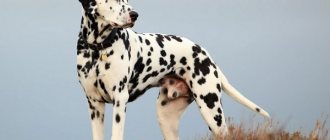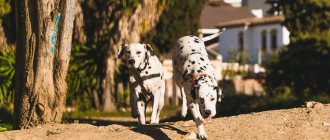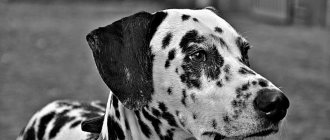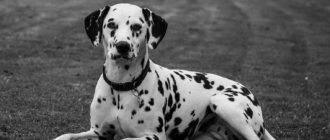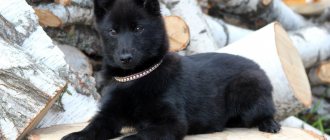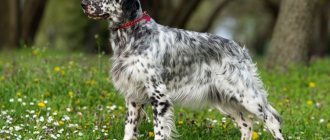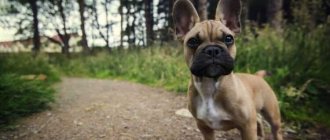| Origin | Croatia |
| Usage | hunter, companion, family dog |
| Color | spotted |
| Dimensions | height 54-62 cm, weight 24-32 kg |
| Lifespan | 11-13 years old |
The Dalmatian is one of the most famous breeds in the world. This is a charming dog with a memorable appearance - smart and loyal. There are negative reviews on the Internet about the intelligence of these animals. However, this is due to improper upbringing - a responsible owner with a strong character will have a pet that will grow up obedient and very loyal.
Dalmatian or Dalmatian: which is correct?
Many dog breeders are interested in the correct name of the breed – Dalmatian or Dalmatian. There are different names in literature and everyday life, which causes confusion.
To find the answer, we must look to history. The pets were named after the historical region of Dalmatia (Balkan Peninsula). Later the dogs were registered under the name "Dalmatian".
The confusion began after the release of Walt Disney's 101 Dalmatians. Then the breed became super popular and people forgot what to call the animals - Dalmatian or Dalmatian.
The breed can also be found under the following names:
- Dalmatian or Dalmatian Dogo;
- Bengal brakk;
- Danish hound;
- harlequin;
- French dog.
Fans mistakenly call these pets “Dolmatian” or “Dolmatian”.
Photo
DalmatianIn this article you got acquainted with the amazing Dalmatian breed, the photo of which is presented above. Friendly and mischievous dogs, loyal protectors and friends, it is not for nothing that they are so loved all over the world.
Interesting facts about the breed:
- Dalmatians are born white, with black spots only on the nose, belly and a little on the paws. As the dog ages, black or brown spots appear all over its body.
- The spotted pattern on the coat of Dalmatians is unique, like the patterns on the fingertips of humans.
- Dalmatians have a real canine language with which they express the variety of their needs. They make sounds of different timbres and change their voice.
Breed standard
The Dalmatian is a strong, muscular, rectangular dog. The animal is distinguished by extraordinary endurance. It is perfectly balanced, adapted to long running.
Dimensions of an adult Dalmatian dog:
- height – 56-62 cm in males, 54-60 cm in females;
- weight – 27-32 kg and 24-29 kg, respectively.
Gender differences are pronounced - Dalmatian females are smaller and more graceful than males.
Official description of the Dalmatian Dogo breed (FCI standard No. 153):
| Become | Breed characteristics |
| Head | Blends harmoniously with the pet's body. Wide between the ears, characterized by a complete absence of wrinkles. The length of a Dalmatian's head is 40% of the animal's height. The stop is clearly marked. |
| Muzzle | The bridge of the nose is straight, the jaws are strong. The length of the pet's muzzle is equal to the length of the skull. |
| Eyes | Slightly elongated. The color of the iris matches the color of the Dalmatian dog. Dogs with partial blue pigmentation are subject to disqualification. These animals have an intelligent, clear, penetrating look, which is noticeable in the photo of the Dalmatian. |
| Nose | Large, fully pigmented. The color of the earlobe matches the shade of the Dalmatian dog's spots. Dogs with insufficient pigment will be disqualified. |
| Lips | Well pigmented. They cover the animal's jaws and never sag. |
| Jaws | Developed, closed in a scissor bite. As Dalmatians age, their bite may change to a pincer-like bite. |
| Teeth | A complete dentition is encouraged, but a few premolars may be missing. Dalmatians missing more than 6 teeth are subject to disqualification. |
| Ears | Triangular, with rounded ends. They sit high, pressed to the sides of the Dalmatian's head. It is important that there are also markings on the ears - a single color is unacceptable. |
| Neck | With developed muscles, quite long - with its help the Dalmatian can easily reach the ground with his nose. Gradually widens as it approaches the shoulders. These animals have no dewlap. |
| Torso | The ratio of the length and height of the pet is 10 to 9. The withers are clearly visible, the back is straight, and the loin is short. Representatives of the breed have a deep chest and a tucked, but not too drawn in, belly at the sides. |
| Tail | Continues the line of the animal’s back, expanding as it approaches the base. Curved in the shape of a saber. Dalmatians with curled tails are disqualified. Spotted coloring is welcome. |
| Limbs | Proportional to the body, strong and muscular. Arranged in parallel. The length of the forelimbs to the elbows is 1/2 of the animal’s height. The fingers are gathered into a ball, the pads are elastic. Good pigmentation of Dalmatian claws is encouraged. |
Dalmatian Dogs have short, shiny and coarse hair. The calling card of these animals is their characteristic spotted color. The Dalmatian breed standard sets certain requirements that the pet's color must meet.
The background color of the animal is pure white, the color of the spots is only black or brown (chocolate). In this case the marks:
- evenly cover the entire body of the pet;
- stand out clearly, especially on the ears;
- do not have white inclusions.
The same size spots are welcome - about 3 cm black, about 2 cm brown. On the head and tail of the animal, the markings are proportionally smaller. The absence of spots is a disqualifying fault; spots on the body of a Dalmatian Dog are considered a fault.
Dalmatians with brown spots are less common than those with black spots.
The simultaneous presence of black and brown spots is not allowed. Pets with lemon, orange, brindle and blue markings are disqualified. What a Dalmatian looks like that meets the breed standard can be seen from the photos of the dogs presented in the article.
The movements of the Dalmatian are energetic, elastic and graceful. The animal pushes off powerfully with its hind limbs and swings its forelimbs well. Representatives of the breed are perfectly adapted to long-distance running.
Aggressive and cowardly Dalmatians, as well as those with pronounced physical and behavioral abnormalities, are subject to disqualification.
A little history
Dalmatians (or Dalmatians - this name is also acceptable) have ancient origins. Rock and funerary images of the breed's ancestors with spots on their bodies, found in Greece and Egypt, date back several thousand years. More recent finds date back to the 14th century: spotted dogs similar to modern Dalmatians were seen in Florentine frescoes.
The exact origin of the Dalmatians is unknown, however, based on the traces of existing artifacts, it can be assumed that their ancestors came to Turkey from the Middle East, then to the Balkan coast and ended up in the province of Dalmatia, which is how they got their name. But this is certainly one of the versions. In different periods, the dog could be called brindle, attributed to the French and Danish hound breeds, and such names as “calico dog” and “harlequin dog” were also relevant for it. Dalmatians were called not only Dalmatian dogs, but also Turkish and Russian dogs. Such diversity testifies to the rich and filled with various stories of the formation of the breed.
There is an opinion that Dalmatians were named after Yuri Dalmatin, who actively promoted the breed, receiving several dogs as a gift
Croatia is recognized as the official homeland of the breed. Britain is considered the second homeland of the animals: the ancestors of the breed, brought from the continent, came there 400 years ago. Dalmatians are also considered to come from warm countries, and this is confirmed by their love for warmth. The spots on the body also do not disprove this theory - the contrasting pattern camouflages the dog in the sun and prevents it from overheating. Breed historians are convinced that the original pattern was not obtained artificially. Nature itself rewarded the Dalmatian with such an unusual color.
Dalmatian has many names
The features of the rock are demonstrated by the shape of the skull of the remains found by archaeologists. In ash deposits dating back to 2-3 thousand years BC, a group of scientists found dogs called “ash dogs”. According to the official version, some hunting breeds descended from them, including the spaniel and bloodhound. However, these ancient animals have the most similar features with Dalmatians.
The Legend of the Dog
An ancient epic of the Indian people describes white dogs with black spots, the ancestor of which was the white tiger of the Bengal breed. This story coincides with the beliefs of the nomads who came to the Balkans from India. According to their ideas, fierce battles constantly take place on our planet between black demons and white angels.
There is a version that animals appeared on the European continent thanks to Indian nomadic tribes
The combination of black and white is present in the religious symbolism of different countries. In ancient times, they could specially cross certain animals to achieve this color. Apparently, the actions aimed at obtaining a specific drawing were ultimately crowned with success, and a Dalmatian was born. The ancient Greek philosopher Xenophon also favored the noble origin of dogs, distinguishing them from other animals.
Development of the breed
According to breed researchers, the characteristics of Istrian Pointers and Great Danes have had a definite influence on the appearance of modern dogs. Thanks to their unique ermine-like pattern, Dalmatians quickly gained popularity among the English nobility. Dogs were associated with the luxury of aristocratic gatherings and homes. But, in addition to the external component, they were also famous for the working qualities of the guards. They began to be taken on trips as accompanying crews.
Crew escort
In ancient images, Dalmatians can be seen with cropped ears - this was due to the continuous movements in which the animals were.
Another area in which Dalmatians have proven themselves to be true professionals is related to firefighting. Being a kind of fire sirens, they noisily dispersed passers-by who found themselves in the way of carts rushing to help the victims. The Dalmatian named Sparky from the USA achieved the greatest popularity. Figures of dogs in helmets are still a symbol and mascot of American fire stations.
Also, dexterous and agile Dalmatians often took part in the performances of circus performers. Their abilities were used in police service, hunting, and during the Second World War - to protect important objects. History records a case when British pilots used the help of a Dalmatian. Under the leadership of an owner named J. Fischer, he took part in three dozen missions over Germany and, after being wounded, was awarded a government award. Later, thanks to this dog, Japanese dog breeders recognized the Dalmatian breed.
Dalmatians are able to accompany the blind and participate in search operations
With the invention of the steam engine, the need to accompany horse-drawn carts gradually disappeared. During this period, the breed experienced a decline in popularity. But after some time, the talents of the Dalmatians were revealed to their owners from a new side. They began to be taken in as companions. At the same time, interest arose in targeted breeding, exterior standards emerged, thanks to which Dalmatians were able to take part in exhibitions. The increase in the number of the breed's population was positively influenced by the appearance of the book about 101 Dalmatians. A few years later, a cartoon of the same name was released, which also increased the demand for the breed. In the USA, puppy sales have increased more than 5 times!
Still from the movie “101 Dalmatians”
Character
The Dalmatian's character is peaceful, balanced and independent. These dogs are extremely charming and charismatic. Animals should not be cowardly, timid, nervous or aggressive - these are serious vices.
The main features of the breed are a sharp mind, high activity, and boundless friendliness. The Dalmatian dog is easy to train and quickly learns commands. Many dog experts believe that this is one of the smartest animals.
The Dalmatian Dog is an incredibly loyal dog. The pet becomes strongly attached to its owner and becomes sad if left alone for a long time. This is a real companion who is always ready to follow a person and help him in all matters. By nature, Dalmatians are very curious - they try to stick their nose everywhere.
Everything about the Dalmatian dog breed
Stately, smart, cheerful - this is all about Dalmatian dogs, which used to be very popular. These dogs make excellent companions and best friends for their owners. They can brighten up loneliness and lift your spirits. They are very active and love to play, are friendly and good with children, which is why they are ideal pets for large families.
Application
Throughout its history, the Dalmatian breed has served many functions. Dogs guarded carriages and horses, cleared the way for fire crews, hunted game and herded livestock. Nowadays, animals are usually kept as companions. However, you need to find a use for the unbridled energy of these pets. For example, do agility or freestyle with them.
Are Dalmatians hunters or not?
Since ancient times, Dalmatians have been loyal companions and excellent hunters. They run very fast, making it easy to catch their prey. They have an excellent sense of smell - they can pick up the scent of game from several kilometers away and persistently pursue it for several hours in a row.
Reference. In the modern world, Dalmatians are rarely taken for hunting, but this is more due to the low popularity of this breed than to its poor hunting qualities.
Socialization
Socialization of a Dalmatian puppy begins immediately after it arrives in the house. The baby is taught to behave correctly and follow a routine. When quarantine ends after vaccinations, the dog is taken outside, where it actively explores the world around it.
The pet must be brought up strictly. The Dalmatian dog is immediately shown that the person is the undisputed leader. Any attempts to dominate are stopped. But Dalmatians do not tolerate violence. These animals are capable of harboring a grudge and doing mischief in response. Excessive cruelty makes dogs angry, uncontrollable and fearful.
Dalmatians get along well with children, as long as they do not go beyond what is permitted. Therefore, younger family members should immediately be told about the dog’s body language and the rules of behavior with the animal. It is better not to leave babies alone with a pet - the dog may accidentally scare or injure him.
With proper upbringing, the Dalmatian dog breed gets along with other pets, especially if the four-legged animals grew up together. Dalmatian dogs also do not conflict with their relatives - clashes are possible only between male dogs. However, animals that consider themselves leaders often chase other tailed animals.
Training and education
Raising an animal must be done immediately when it gets into the house. On the very first day, you need to establish rules that the pet will adhere to for the rest of its life: do not beg for food, do not bite during play, do not sleep in the same bed, etc. It is extremely difficult to retrain an adult dog.
The main rules that should be followed during training:
- unanimity (the whole family must demand compliance with the established rules);
- subsequence;
- persistence.
You can reward your pet for following commands by giving him a treat. You can scold for pranks, but never use force.
The first command that a puppy must learn is “no”. A Dalmatian who has mastered the command will grow up obedient and pacify his restless character. If the owner does not demand constant execution of the command, the puppy may take advantage of this and stop obeying the person.
How to choose a puppy
Choosing a puppy is an exciting, but at the same time very responsible task. Before buying a Dalmatian, you need to study information about the breed - such an energetic animal is not suitable for every person. It is worth reading reviews from other owners and talking to breeders involved in breeding Dalmatian Dogs. You can visit exhibitions to get a complete picture not only from photos of Dalmatians, but also from live communication with these pets.
Then they determine the sex of the animal:
- Dalmatian dog bitches are more obedient and affectionate;
- Dalmatian males are stronger, more independent and stubborn. They must be raised by a person with a steady hand.
Next, you need to choose a reliable nursery. It is not recommended to buy Dalmatians by hand - puppies without documents often have congenital pathologies or do not meet the breed standard.
To identify a responsible breeder, you need to ask him a few questions - how long has he been breeding Dalmatians, what does he feed the animals, in what conditions does he keep them, etc. A conscientious seller will provide the necessary information, tell you everything about Dalmatian dogs, and point out the advantages and characteristics of each baby.
Photos of Dalmatian puppies are touching, but the litter must be inspected in person. Animals may have abnormalities that are not visible on photographs. Pets also have different personalities: some are more playful and self-confident, others are calm and slow.
Healthy Dalmatian puppies are active, curious, playful, and moderately well-fed. Animals will probably happily run to meet each other when they see a new person. Lethargy or excessive thinness of Dalmatian dogs are the first signs of illness.
It is advisable to meet the puppies’ parents in person, not through photographs. Dogs can have not only defects in appearance, but also in temperament, which is also inherited.
An interesting nuance is that Dalmatian puppies are born without spots. Markings appear within the first 10 days. And the final coloration of Dalmatian dogs is formed only by 12 months. Animals that are born with spots are considered defective and are not allowed to breed or participate in exhibitions.
Who shouldn't adopt a Dalmatian?
Regardless of how attractive Dalmatians seem to you, soberly assess your strength and the amount of free time before buying a puppy. The main “contraindications” for this breed are related to the size and temperament of the dogs.
It’s quite possible to borrow someone else’s pet for a photo shoot.
A large, impetuous, strong and active dog that needs to be attacked. Which you will need to be able to hold on to the leash if she breaks out. Which needs to be trained long and hard. Perhaps carried in your arms in old age or during illness.
To whom I do not recommend getting a Dalmatian:
- To old people.
A young Dalmatian is a mad hurricane, and the large size of these dogs increases the risk of not being able to cope with such a pet.
- Families with small children.
A Dalmatian will not knowingly harm a child, but as a puppy it can constantly knock it down and injure it with its claws. The Dalmatian is an eternal child, only 30 kilograms and very fast. Are you sure you can handle two?
A puppy is not only a joy, but also a huge hassle
- Busy people.
If you are away at work all day and there is no one at home, it is better to choose a different breed. Dalmatians do not tolerate loneliness well, boredom causes destructive behavior. The situation becomes tense if porcelain vases from the Qin dynasty are placed at home, in other words, expensive repairs are made, a leather sofa is bought, and so on...
I'll help you stay in great shape, but I can't sit at home alone.
- People with limited income.
It sounds cynical, but if you have a small salary, do not take a Dalmatian or another large dog. The cost of veterinary services increases significantly with the weight of the dog, unless we are talking about vaccination or a routine examination. Even a completely healthy Dalmatian needs high-quality food, treatment for external and internal parasites, vaccinations, chewing toys, clothing, a large bed and much more.
Features of maintenance and care
It is better to have Dalmatians for owners of houses with a spacious garden plot. However, many dog breeders practice keeping these pets in an apartment. This option is only possible if there is a long walk - it is very difficult for the Dalmatian Dog to be confined within four walls. Due to lack of movement, the animal will destroy everything it can reach.
Grooming
Caring for a Dalmatian is quite simple - the breed is quite unpretentious. All you need is:
- brushing the Dalmatian dog's coat a couple of times a week, daily during shedding;
- regular ear examination and cleaning;
- trimming nails if the Dalmatian dog does not grind them down on his own;
- when feeding natural food, brush your teeth with veterinary paste. You can periodically give your pet bones or dental treats to chew on.
The advantage of Dalmatians is the absence of dog smell. Representatives of the breed are also very clean. During walks, the animals carefully avoid mud and puddles, so they rarely get dirty - Dalmatian dogs are bathed once every six months. You should not wash your pet more often so as not to disturb the natural structure of the coat.
Walk
The Dalmatian is a very energetic and active dog that requires regular exercise. If the pet lives in an apartment, take at least 2 hours for walks. Representatives of the breed love to swim and spend time in nature - here the animals can give free rein to the innate instinct of the hound.
The more the Dalmatian moves, the more balanced and obedient he is.
Feeding
Dalmatian dogs are very demanding when it comes to food. When choosing ready-made food, you should purchase premium or super-premium products. Low-quality food does more harm to pets than good. Animals often suffer from food allergies - Dalmatian dogs are not suitable for foods high in protein.
When feeding natural food, special attention is paid to compiling a Dalmatian diet:
- The basis of animal nutrition is lean meats and offal.
- Every day, dogs are cooked porridge - barley, buckwheat or rice - with the addition of vegetables. It is not recommended to give other cereals - pearl barley and millet are poorly digestible, and regular consumption of rolled oats causes yellowing of pets' fur.
- Fermented milk products (cottage cheese, kefir, yogurt) are very useful - they improve digestion.
- 1-2 times a week, Dalmatians' menu includes sea fish and eggs.
- From time to time, the animals are pampered with fruits - most Dalmatians love apples. In summer, pets are given fresh berries.
To make the Dalmatian's coat shine better, sunflower oil is added to the food. In consultation with the veterinarian, vitamin and mineral complexes are selected.
Let's sum it up
So, the choice in favor of the Dalmatian has been made. The advantage of the breed is the dog’s character, which, subject to consistent training and some firmness in the owner’s mood, shows the best qualities - a friendly and kind attitude towards family members, a flexible mind, a cheerful disposition, activity on walks and a willingness to follow a person. Active people who spend their free time on the move will appreciate their four-legged companion. The dog is in good health, and with proper care, illnesses of varying severity practically do not threaten it. Caring for dogs of this breed is easy, and even a child can handle it. In addition, Dalmatians happily play with children of all ages.
Dalmatian is a sporty and intelligent dog
An owner who cannot afford to walk a pet for a long time and with quality risks getting problems in the form of damage to property, changes in behavior - isolation or, on the contrary, excessive activity and aggression. The Dalmatian is not very comfortable in the apartment. It is advisable for the dog to live in a country house. A wayward animal is not always easy to train, given the level of intelligence, some stubbornness and difficulties with concentration. The breed is relevant for experienced dog breeders. It is sometimes difficult for a beginner to find a balance between persistence and suppressing the will of the animal. In terms of nutrition, Dalmatians are quite picky and can react violently to the slightest changes in diet through allergic manifestations.
An active animal requires physical activity
The Dalmatian needs a lot of time and attention. Smart and active, he demands that his owner become his friend. The dog should not be taken into the home of elderly or busy people, those with a phlegmatic temperament, or those who like to stay indoors. Travelers, athletes, lovers of cycling and running will be good partners for the Dalmatian.
Health
The Dalmatian breed is quite strong and hardy. Dogs live on average 12 years. However, in pets with good heredity, life expectancy can increase to 16 years if the animals are provided with proper care.
Diseases
The Dalmatian dog breed is susceptible to the following diseases:
- atopy;
- colic;
- hip dysplasia;
- dermatitis;
- demodicosis;
- cataract;
- glaucoma;
- urolithiasis disease.
Dalmatians are often born deaf. Such animals are culled.
When the first symptoms of illness appear (lethargy, gastrointestinal upset, vomiting, loss of appetite), Dalmatian dogs, like other dogs, are immediately taken to the veterinarian.
Vaccinations
Dalmatian puppies are vaccinated according to the general vaccination schedule. The breeder gives the first injections to Dalmatian dogs at the age of 8-9 weeks - by this time the immunity transmitted through mother's milk weakens. Animals are protected from common diseases:
- carnivore plague;
- enteritis;
- parvovirus;
- parainfluenza.
After 3-4 weeks, a second vaccination is carried out; at 6 months, Dalmatians are vaccinated against rabies. Adult animals are revaccinated annually. Once every 3 months, pets are treated for worms and blood-sucking parasites.
Veterinarians adjust the vaccination schedule for Dalmatians taking into account the conditions of detention and the prevalence of diseases in a certain area.
How long do representatives of the breed live?
On average, Dalmatians live from 10 to 13 years, provided that they received all their vaccinations on time, and with food they received all the vitamins and microelements the body needs. Naturally, the better an animal is cared for, the longer it lives. In rare cases, a Dalmatian can live up to 20 years.
Mating
Only functionally and clinically healthy Dalmatians that do not have deviations from the breed standard are allowed for breeding. Bitches are bred after the onset of the third heat, males - at 20-22 months.
The animals are first introduced on neutral territory, then the bitch is brought to the male. The most suitable days for conception are from 9 to 14 from the beginning of estrus. Dalmatian dogs are bred freely, but inexperienced animals sometimes require human help. For beginners, it is better to call a professional breeder who can control the process.
On average, a Dalmatian's pregnancy lasts 60-64 days. In the same litter, puppies are born with both black and brown spots. Any parents can have babies with congenital spots - most breeders discard such animals.
What can your pet get sick with?
Continuous shedding with hair loss in certain areas may indicate an allergy. Self-medication in this case is not encouraged - consultation with a specialist is required.
If signs of illness are detected, you should contact a veterinarian
In general, dogs are not prone to disease and often live up to 12-15 years (there are cases when the life expectancy of dogs is even longer). However, you should be aware of the breed's weaknesses, which can be presented as a list of ailments:
- Intestinal problems in the form of bloating.
- Defects of the hip joints in the form of dysplasia .
- Interdigital dermatitis and other manifestations of allergies .
- Cramps.
- Eye diseases: cataracts, glaucoma, retinal atrophy may occur.
- Hypothyroidism.
There is a particular tendency to form stones in the urinary ducts. This pathology is associated with a congenital feature of Dalmatians: they have a special composition of urine. The level of uric acid is not comparable with the composition of urine of other breeds.
At the first signs of kidney problems in this area, the veterinarian will advise limiting proteins in the pet’s diet.
Dalmatian deafness is also common. Each puppy in the litter should be checked for this defect, since the percentage of damage is not so small - 10-12% of animals have hearing impairment. The easiest way to do this is with a sleeping dog. The animal should wake up from a sharp noise. If the puppy is awake, sharp sounds should cause a reaction in the form of curling up the ears and moving the head in a certain direction. The problem is excessive fearfulness and aggression of dogs with deafness, as well as difficulties with training.
To avoid unpleasant surprises, you should purchase puppies from responsible breeders.
To prevent ear diseases, you should not allow hypothermia, since Dalmatian ears are very thin.
Hearing defects hinder the training process
How much does a Dalmatian puppy cost?
The cost of Dalmatian puppies depends on the title of the parents, the reputation of the nursery and exhibition prospects:
- the price of a pet-class Dalmatian is 5-10 thousand rubles;
- the cost of breed-class animals is 15-20 thousand rubles;
- show-class pets are more expensive – from 30 thousand rubles.
One litter can produce both a high-quality Dalmatian puppy and an outright purebred.
Nurseries
There are not many breeders in Russia engaged in breeding Dalmatian Dogs - there are kennels only in a few large cities. Pedigree puppies of this breed are sold:
- in Moscow - nurseries “Symphony of Stars” https://dalmatin-stars.ru/, “New game” https://kennel-new-game.wixsite.com/dalmatian;
- in St. Petersburg - nursery “S Nevskie Ostrov” https://dalmatian-spb.ru.
The Dalmatian dog will be a wonderful companion for an active person who loves traveling, long walks and jogging. If the future owner does not have free time, it is worth taking a closer look at another breed - less active and sociable.
Features of Dalmatians
Dalmatians have a number of features unique to this breed of dog - 10–12% of puppies are born deaf .
Advice! It is important to immediately check the hearing abilities of each born puppy, since keeping deaf dogs is a very difficult task, they are almost impossible to train, many of them become uncontrollable and aggressive. In addition, when they get outside, they can get hit by a car.
There is an opinion that Dalmatians are the stupidest dogs of all, but this is absolutely not true!
These are smart, understanding dogs that are highly trainable, but they are hampered by their restlessness. They cannot focus on one activity for a long time (especially at a young age), following a command, they immediately run about their business.
But over time these problems go away. Dalmatians do not tolerate cold well and can easily get frostbite on their paws and ears in winter, so it is advisable to go for walks more often, but for a short period of time. If possible, the dog should be dressed in warm clothing. Paws need to be constantly inspected for damage, as reagents on the roads can corrode the delicate pads.
Many Dalmatians suffer from allergies and otitis media at a young age .
They need constant physical activity, long walks and a lot of movement, otherwise they will create chaos in the house due to an excess of unspent energy.
Origin of Dalmatians
The exact date of the appearance of the first spotted representative of the breed is unknown, but images of Dalmatians can be found in artistic and church paintings dating from the 16th to 18th centuries. The breed received its name due to its supposed homeland - the province of Dalmatia in Croatia, but scientists were unable to determine the exact region of origin. The Englishman Vero Shaw first tried to standardize the breed in 1882, but his document became official only 8 years later, when the English Dalmatian Club was formed. The breed received recognition from the International Canine Federation and the standard in its system in 1955 and was named “Dalmatian Hunting Dog” (No. 153) . Today, representatives are called by many different names, including Dalmatians and Dalmatian Great Danes.
